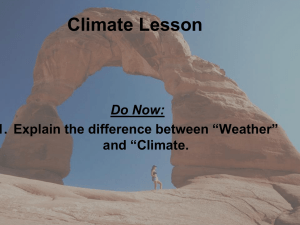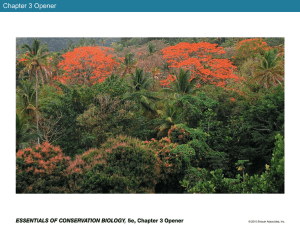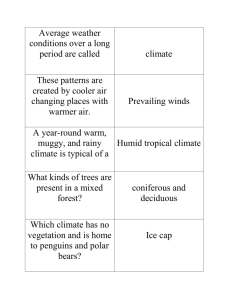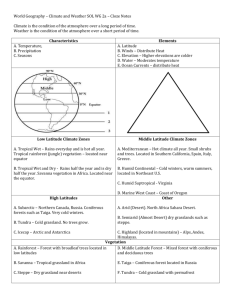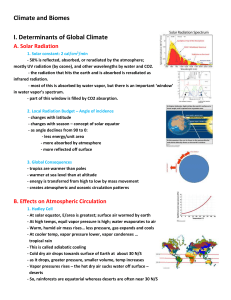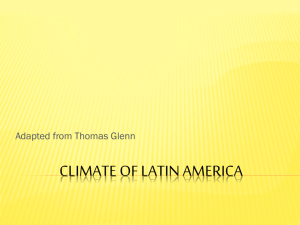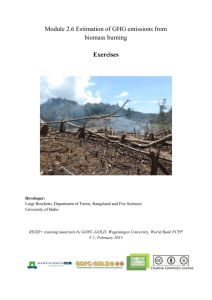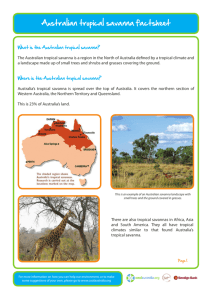Study Guide with Answers
advertisement
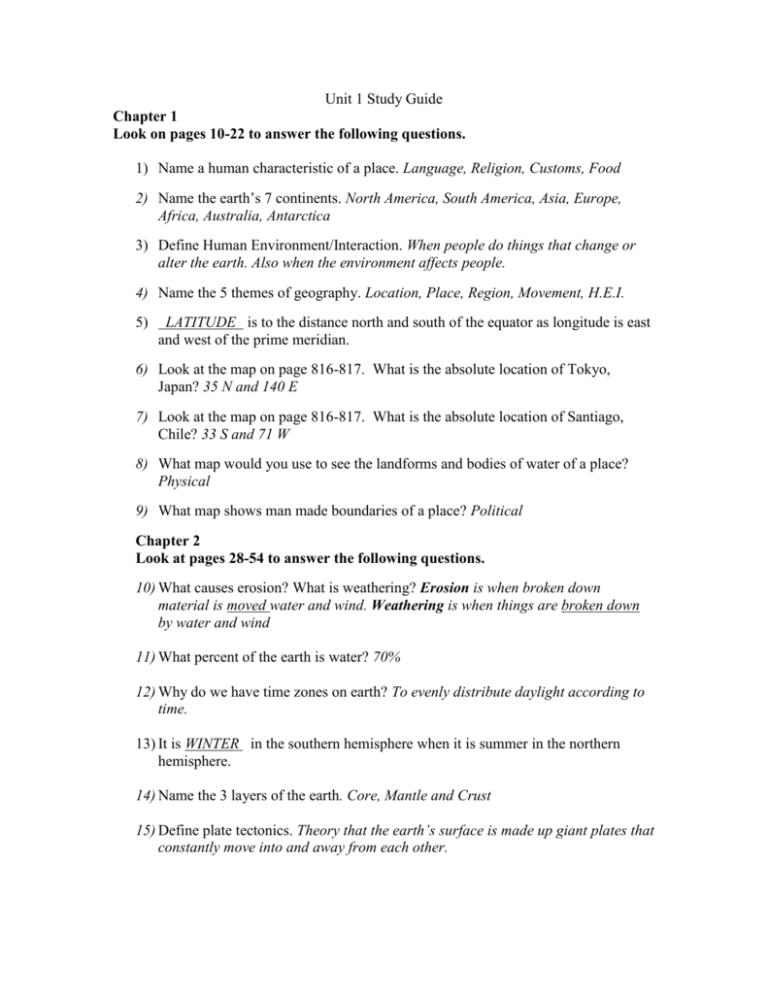
Unit 1 Study Guide Chapter 1 Look on pages 10-22 to answer the following questions. 1) Name a human characteristic of a place. Language, Religion, Customs, Food 2) Name the earth’s 7 continents. North America, South America, Asia, Europe, Africa, Australia, Antarctica 3) Define Human Environment/Interaction. When people do things that change or alter the earth. Also when the environment affects people. 4) Name the 5 themes of geography. Location, Place, Region, Movement, H.E.I. 5) LATITUDE is to the distance north and south of the equator as longitude is east and west of the prime meridian. 6) Look at the map on page 816-817. What is the absolute location of Tokyo, Japan? 35 N and 140 E 7) Look at the map on page 816-817. What is the absolute location of Santiago, Chile? 33 S and 71 W 8) What map would you use to see the landforms and bodies of water of a place? Physical 9) What map shows man made boundaries of a place? Political Chapter 2 Look at pages 28-54 to answer the following questions. 10) What causes erosion? What is weathering? Erosion is when broken down material is moved water and wind. Weathering is when things are broken down by water and wind 11) What percent of the earth is water? 70% 12) Why do we have time zones on earth? To evenly distribute daylight according to time. 13) It is WINTER in the southern hemisphere when it is summer in the northern hemisphere. 14) Name the 3 layers of the earth. Core, Mantle and Crust 15) Define plate tectonics. Theory that the earth’s surface is made up giant plates that constantly move into and away from each other. 16) Name 2 factors that form mountains on earth. Plates colliding and forcing the earth upwards and Volcanoes can form mountains’ over time too 17) Define the following: a) Peninsula Land surrounded by water on 3 sides b) Isthmus Narrow strip of land that connects two larger land masses c) Island Land that is completely surrounded by water d) Strait Narrow opening of water that connects two larger bodies of water 18) What is the stage of the water cycle that turns liquid water into a gas? Evaporation 19) Name the last stage of the water cycle where rain, sleet, or snow falls to the ground. Precipitation 20) What part of the earth do warm ocean currents come from? Near the Equator 21) What is the climate like close to the equator? Tropical 22) What factor most influences a place’s climate? Closeness to the Equator (Latitude) 23) What is a biome? The plants and animals that make up an ecosystem 24) Define hurricane and typhoon. They are both Tropical Cyclones. Hurricanes form in the Atlantic. Typhoons form in the Pacific. 25) Why are high latitude climates cold? Because they are farther from the equator and get less direct sunlight. 26) Name the 3 stages of the water cycle. Evaporation, Condensation, and Precipitation 27) What climate lies closest to the equator? Tropical 28) What type of climate would you most likely find in a mountainous area? The higher the elevation the colder it gets. The top of Mt. Everest is Polar like climate 29) Name the 4 mid-latitude climates. 30) When does it rain in a Mediterranean climate? In the Winter 31) What is the difference between a tropical rainforest and a tropical savanna climate? Tropical rainforest gets rain all year long, Tropical Savanna has a WET and DRY season 32) Describe a Tundra climate. Very cold winters with short cool summers. Vast treeless plain were only grasses and mosses grow in the summer. 33) What is a deciduous forest? What is a coniferous forest? Deciduous forests have trees that lose their leaves in the winter. Coniferous trees bare cones and are green year round Chapter 3 Look at pages 60-84 to answer the following questions. 34) Why are people living longer? Better health care and food readily available 35) What is population density? How many live in area per square mile or kilometer 36) What are 3 problems caused by overpopulation? Food shortages, not enough jobs, housing shortages, and increased pressures on the environment 37) Give 3 reasons people are pushed to another country. War, Poverty, No Jobs 38) Give 1 reason people might be pulled to a country. Better Opportunities 39) What is an immigrant? Someone who moves to a country from another country 40) Define migration. The movement of a group of people from one country to another 41) What is the difference between a capitalist economy and a communist economy? Capitalist economy allows for private ownership of business, Communist economy the government owns all business 42) Describe a developed nation and a developing nation. A Developed country has high technologies and the majority of the people will work in 3rd level activities and have a higher standard of living. A Developing country most people work in level 1 or 2 activities and have few technologies and their standard of living is low. 43) Define the following governments: a) Direct Democracy Citizens have direct control of the government and vote directly on issues b) Dictatorship A government where one leader takes and maintains power by force c) Representative Democracy Citizens vote on government officials to run the government and make decisions d) Constitutional Monarchy Government where Kings and Queens share power with an elected officials who the majority of power e) Absolute Monarchy Kings and Queens (Monarchs) have complete control of their country 44) What is the difference between birthrate and death rate? Birthrates are the # of live birth per 1,000 people in a country. Death Rates are the # of deaths 45) Which continent has the highest population? Asia 46) As population continues to grow, why do think there will be more conflict over natural resources? Resources are NOT distributed equally around the world and the more people there are the more valuable they become Chapter 4 Look at pages 92-101 to answer the following questions. 47) Define culture. They way people live. 48) Give 5 examples showing someone’s culture. Their language, religion, clothes, customs and food they eat are examples. 49) What is a civilization? An advanced culture with cities and a system of writing 50) What type of language family does North and South America speak? Latin 51) Name the 5 major religions of the world. Christianity, Islam, Buddhism, Hinduism and Judaism 52) Why does North and South America follow Christianity? Because European explores and missionaries brought their beliefs with them during age of exploration and colonization 53) Define cultural diffusion. Movement of customs and beliefs 54) What technologies have affected the change of cultures over time? Factories and the Industrial Revolution, Cars, Cell Phones, Computers and Internet 55) What is acculturation? Accepting new ideas and fitting them into a culture Chapter 5 Look at pages 114-132 to answer the following questions. 56) What is the difference between a renewable and nonrenewable resource? Renewable resources can be renew easily, nonrenewable take millions of years to be renewed 57) Define fossil fuel. Natural energy resource that is made from ancient plant and animal decay millions of years ago 58) Give 3 examples of a fossil fuel. Petroleum, Natural Gas and Coal 59) Name 3 nonrenewable sources of energy. Petroleum, Natural Gas and Coal 60) Name three alternative sources of energy that are renewable. Wind, Solar, and moving Water 61) What is a city doing if it is sprawling outward? It is growing and expanding outwards with suburban neighborhoods surround the city 62) What is deforestation, and how does it affect the environment? The cutting down of trees. Forests give us oxygen and they also are a part of an ecosystem that other plants and animals depend on. 63) How can we stop deforestation? Recycle more and plant trees after cutting them down. 64) What is a raw material? A natural resource that must be worked on to be useful. 65) How have second and third level activities changed the environment? 2nd Level factories have polluted the water and air. 3rd Level transportation of goods and energy needs have polluted the air and caused more strain on energy resources 66) What is a civil engineer? Someone who builds structures that alter the earth’s landscape. Ex Dams, Bridges and Roads 67) What are some causes of pollution and how can we decrease pollution? Cars, Factories, Littering, and landfills are a few causes. Conserve energy at home, car pool and drive hybrid cars, use clean energy for factories and Recycle trash are few ways we can decrease pollution.
